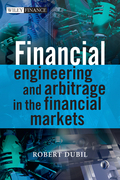
ÍNDICE: 1. The Purpose and Structure of Financial Markets. 1. Financial Markets Overview. 2. Risk Sharing. 3. The Transactional Structure of Financial Markets. 4. Arbitrage: Pure vs. Relative-Value. 5. Financial Institutions: Transforming Intermediaries vs. Broker-Dealers. 6. Primary (Issuance) and Secondary(Resale) Markets. 7. Market Players: Hedges vs. Speculators. 8. The Preview of the Book. Part I. Relative Value Building Blocks. 2. Spot Markets. 2.1 Bondsand Annual Bond Math. 2.2 Intra-Year Compounding and Day-Count. 2.3 The Term Structure of Interest Rates and The Discount Factor Bootstrap. 2.4 Interest Rate Risk: Duration and Convexity. 2.5 Equity, Commodity and Currency Math. 2.6 Short-Selling. 3. Futures Markets. 3.1 Fundamentals of Futures and Forwards. 3.2 Futures Mechanics. 3.3 Cash-and-Carry Arbitrage. 3.4 Futures Not Subject toCash-and-Carry. 3.5 Yield Curve Construction with Interest Rate Futures. 4. Swap Markets. 4.1 Fundamentals of Swaps. 4.2 Interest Rate Swaps. 4.3 Cross-Currency Swaps. 4.4 Equity, Commodity and Exotic Swaps. 5. Options on Prices and Hedge-Based Valuation. 5.1 Call and Put Payoffs at Expiry. 5.2 Composite Payoffs at Expiry. 5.3 Option Values Prior to Expiry. 5.4 Options and Forwards, Risk Sharing and Put-Call Parity. 5.5 Currency Options. 5.6 Binomial Options Pricing. 5.7 The Black-Scholes Model and Extensions. 5.8 The Residual Risk of Options: Gamma, Vega and Volatility. 5.9 A Real-Life Option Pricing Exercise. 6. Options on Non-Price Variables. 6.1 Black Models for Bond Price Options, Cap/Floors, and European Swaptions. 6.2 Convexity-Adjusted Models for Libor Forwards, Quantos, and Constant Maturity. 6.3 Arbitrage-Free Interest Rate Models. 6.4Exotic Interest Rate Options. 7. Default Risk and Credit Derivatives. 7.1 Credit Default Swaps. 7.2 A Constant Default Probability Model. 7.3 A Deterministic Credit Migration Model. 7.4 A Poisson Model of Single Issuer Default. 7.5 The Default Correlation of the Reference Issuer and the Protection Seller. PartII. Cash Flow Engineering. 8. Structured Finance. 8.1 A Simple Classificationof Structured Notes. 8.2 Interest Rate and Yield Curve-Based Structured Products. 8.3 Asset Class-Linked Notes. 8.4 Insurance Risk Structured Products. 9. Mortgage Backed Securities. 9.1 Mortgage Financing Basics. 9.2 Prepayment Risk. 9.3 Mortgage Pass-Through Securities. 9.4 Collateralized Mortgage Obligations. 9.5 Multiclass and Non-vanilla CMOs. 10. Collateralized Debt Obligation (CDOs) and Basket Credit Derivations. 10.1 Collateralized Debt Obligations. 10.2 Basket Credit Derivatives. 10.3 Copulas and the Modeling of Default Correlation. 10.3 Synthetic CDO Tranche Pricing and Loss Analysis. 10.4 Credit Derivative Indexes. Part III. The Players. 11. Individual Investors: A Survey of Modern Investment Theory. 11.1 A Brief History of Investment Thought. 11.2 Free Cash Flow Valuation of Companies. 11.3 The Modern Portfolio Theory and the CAPM.11.4 Multifactor Index Models. 11.5 Fundamenta
- ISBN: 978-0-470-74601-1
- Editorial: John Wiley & Sons
- Encuadernacion: Cartoné
- Páginas: 368
- Fecha Publicación: 02/09/2011
- Nº Volúmenes: 1
- Idioma: Inglés
